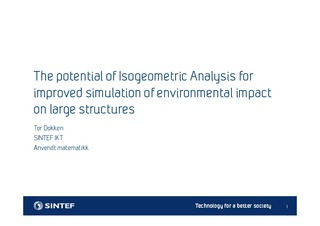| dc.contributor.author | Dokken, Tor | |
| dc.date.accessioned | 2017-02-13T13:25:20Z | |
| dc.date.available | 2017-02-13T13:25:20Z | |
| dc.date.created | 2015-09-24T20:49:12Z | |
| dc.date.issued | 2011 | |
| dc.identifier.citation | Industrial Gaming 2011 - ""Episode IV"" | nb_NO |
| dc.identifier.uri | http://hdl.handle.net/11250/2430596 | |
| dc.description.abstract | In isogeometric analysis introduced by T.J.R. Hughes in 2005 traditional Finite Elements are replaced by NonUniform Rational B-splines (NURBS) to introduce accurate Computer Aided Design (CAD) quality shape representation of in partial differential equation (PDE) based simulation systems. CAD represents volumes by describing their inner and outer surface. This is opposed to the representation in analysis where the complete volume is represented mathematically. Isogeometric analysis uses a 3-variate NURBS representation, contrary to the 2-variate representation in CAD. The research into isogeometric analysis the last five years has demonstrated that the approach is more accurate than traditional Finite Element Analysis (FEA). Further the traditional meshing of the finite element model is replaced by refinement of the spline model with no changes to the shape. This allows direct coupling of the analysis and shape modification imposed by the PDEs solved, and adaptively refine the analysis model if higher accuracy is needed. | |
| dc.description.abstract | The potential of Isogeometric Analysis for improved simulation of environmental impact on large structures | |
| dc.language.iso | mis | nb_NO |
| dc.title | The potential of Isogeometric Analysis for improved simulation of environmental impact on large structures | nb_NO |
| dc.type | Lecture | nb_NO |
| dc.identifier.cristin | 1272815 | |
| cristin.unitcode | 7401,90,11,0 | |
| cristin.unitname | Anvendt matematikk | |
| cristin.ispublished | true | |
| cristin.fulltext | postprint | |
